Genre: Racing Developer: Vivid Image Publisher: Ubi Soft Players: 1-4 Released: 1995
Street Racer appeared on several formats in 1995. The goal when creating this game appeared to be to produce a racer that didn’t just involve using the cars to race, and while this doesn’t make for an exactly unique experience, it certainly made for a refreshing alternative for all the racing game players out there.
Of course, in today’s gaming world we are flooded with cartoon racers. Crash Bandicoot’s done it, Diddy Kong’s done it, Mario has done it a further three times. Hell, even the Toy Story characters have revved up their engines to join in the fun. Back in 1995, however, the only really well known cartoon racer was the original Mario Kart, so at the time, Street Racer seemed kind of different, with not a franchised character in sight. The characters that were available were a lovable bunch – there was Sumo San: the sumo wrestler from the future, Surf Sister: the Australian beach bunny, Hodja the old guy, and Frank the… Frankenstein’s Monster, among others (eight in total). Each character had three home courses, and a hidden course was also unlockable, meaning the number of courses available was pleasingly large.
As well as the standard championship modes, it was also possible to select which courses you wanted to use in the Custom Cup option. This added much more variety into the mix, and was a welcome addition – you could make the game longer or shorter this way, making it perfect for long sessions, or quick games before you went down the pub. Other options available were the soccer mode, in which you used your (still car-bound) characters to play a game of football, the aim being, obviously, to score the most goals, and the Rumble mode, which came in two difficulty settings, which involved trying to knock your fellow racers off the edge of the arena. This mode, however, tended to get repetitive, and the arena seemed to become a little too empty when it was down to the last few players.
In keeping with the less serious approach, your characters came armed. In true Road Rash style, you were able to beat the life out of your opponents in your attempt to make it to the pole position. Additionally, dynamite could be picked up and passed onto other players. The player holding the dynamite when it detonated ground to a halt, costing precious seconds. F-Zero-style speed boosts were accumulated after each lap, and could also be picked up on the course, although unlike F-Zero, there were no tactics as to when was best to use them.
The graphics and sound in this game really seemed to push the Mega Drive – you could tell that a lot of effort had gone toward making something special for the ailing console. The added bonus of four-player potential meant that this became one of the Mega Drive’s better party games, and added an extra sheen of quality to the mix.
At the time the game wasn’t quite original, and it is even less so now, but it still manages to be great fun and isn’t that what really matters?
SCORE: 8 out of 10

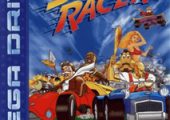
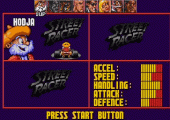
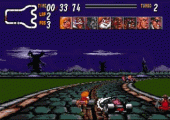
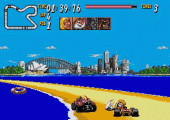
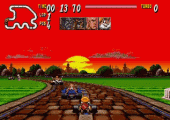
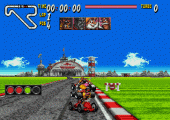
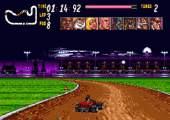
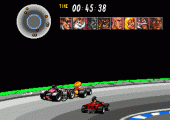
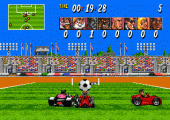
When I saw Snes’s version gameplay with it’s Mode 7 I just ruined my eyes (the graphics is so florid because there are so many lil textures that move, enlarge and rotate). So now I would better play Genesis version, even if it has no “psyho” mode 7..